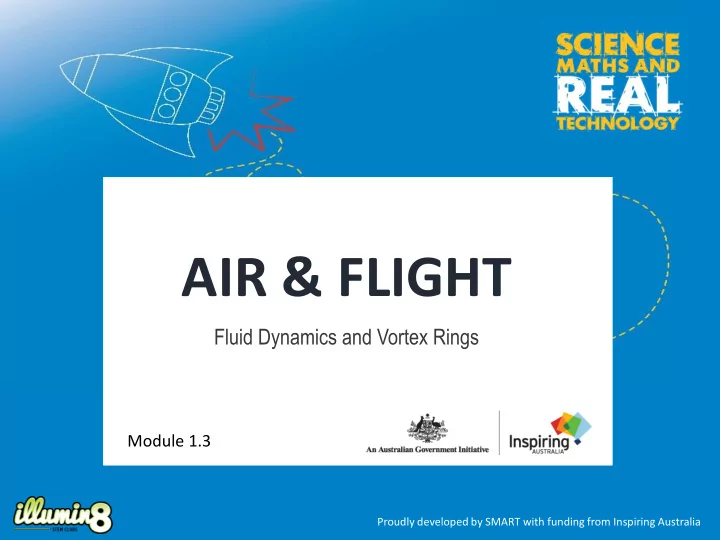

AIR & FLIGHT Fluid Dynamics and Vortex Rings Module 1.3 Proudly developed by SMART with funding from Inspiring Australia
http://mpegmedia.abc.net.au/science/articles/mp4/bubblerings.mp4 Video of underwater bubble rings by the Surfing Scientist, ABC Science
Two types of flo low: Smooth: Laminar Flow Rough: Turbulent Flow Image Source: http://www.education.com/science-fair/article/thick-liquids-faster-slower-thin/
Aim: To observe how laminar flow affects the mixing of fluids Equipment: (per group) • 1 x wide, short clear cup • 1 x narrow tall clear cup • Food colouring (3 colours) • 3 x droppers, or straws • 3 x small cups or containers • 4 x bulldog clips • Liquid hand soap Procedure (set up): 1. Form into groups of 2 to 4 students. In groups: 2. Fill the wide, short cup 1/3 full with liquid soap. Minimise air bubbles. 3. Fill the narrow, tall cup with water and place it inside the wide cup. 4. Ensure the tall cup sinks to the bottom. Clip the bulldog clips, evenly spaced, around the rim of the wide cup, resting against the inner narrow cup. 5. Dispense a small droplet of liquid soap into each of the three small containers. 6. Add a drop of a food colouring to each container (a different colour in each). 7. Slowly mix the colours into the soap (minimise air bubbles). Image Source: http://www.abc.net.au/science/articles/2013/01/30/3679522.htm
Procedure (experiment): When the coloured soap and clear soap are free of air bubbles: 1. Use a dropper / straw to suck up a droplet of liquid from one container of coloured soap. 2. Place the tip of the dropper / straw into the clear liquid soap inside the wide cup (about halfway down the cup), then squirt the coloured soap out of the dropper and into the clear liquid soap. 3. Repeat this with the remaining two coloured soaps, squirting the droplets next to each other. There should now be three blobs of colour in the liquid soap inside the wide cup. 4. Spin the narrow cup slowly inside the wide cup, in a clockwise direction. Make sure you hold onto the wide cup so it is stabilised. The colours should begin to mix. 5. After rotating in a clockwise direction for 3 rotations, stop, and turn the narrow cup back the other way for 3 rotations (anticlockwise). 6. Observe the effect on the coloured soap. Document your observations!
How do Toroidal Vortexes work? ‘Toroid’ is the mathematical name for a doughnut shape Image Source: https://skullsinthestars.com/2012/08/28/physics-demonstrations-vortex-cannon/
Aim: To observe how toroidal vortices form. Equipment: (per student) • 1 x tall clear cup • Food colouring • Dropper (or straw) • Water • Paper towel Procedure: 1. Fill a cup to the brim with water. 2. Let the cup stand for at least 1 minute so the water is completely still. 3. Draw up a single drop of food colouring, and dangle it just above the surface of the water. 4. Touch the water surface with the drop of food colouring. 5. Observe closely, looking down on the water surface. Document results! http://www.abc.net.au/science/surfingscientist/toroidalvortex.htm
Build a vortex cannon out of cardboard and try to knock over a tower of plastic cups! We will record: • The distance from which you shoot your vortex cannon • The number of cups you knock down
Vortex Cannon Challenge: • Build a vortex cannon out of a cardboard box and a few other small items. • The cannon should have a round opening for the vortex ring to come out of. When you hit the sides of the box, air will be pushed out of the opening, forming a toroidal vortex. • The cannon will be ‘fired’ from on top of a table, and aimed at a stack of plastic cups on another table. • The cannon may be filled with smoke using a smoke machine prior to firing. This can help make the toroidal vortices visible to assist with aiming. • The further away your cannon is from the cups and the more cups you knock down – the higher your score!
Vortex Cannon Challenge Rules: • Your cannon must be fired from on top of a table. • The plastic cup stack must be a pyramid shape, with a base of 5 cups in a single line on a table. • You will have 3 official attempts at each distance. The best one is scored. • Testing will begin at a 1 metre distance between tables, and will increase in distance by 1 metre each round. If you do not successfully knock down any cups, you cannot progress to the next distance. • The final score will be the distance, times the number of cups from each round, added together.
Recommend
More recommend